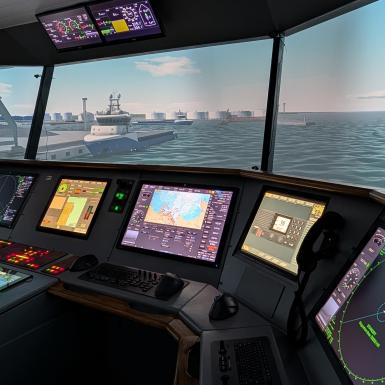The aim is to contribute to the development of the maritime sector in Estonia and the Baltic Sea region through applied research and projects.
To support the high quality research, we also use the numerous possibilities offered by our Simulator Centre. These include planning optimised and safe journey, testing the suitability of different port structures, pollution response and SAR operations
MAIN AREAS OF RESEARCH
MARITIME TRANSPORT
Maritime transport includes both freight and passenger transport. Almost 90% of the goods are transported by sea. Demand for transport is growing, which in turn encourages supply chain management developments to remain competitive. The traditional transport service has been supplemented by terminal and warehousing services, agency and chartering, etc., which are closely linked to the digitalisation of maritime transport and the accompanying changes in the functioning of the maritime sector, education and research and development.
 More
MoreGREEN MARITIME TECHNOLOGY
Aim is the implementation of the principles and strategies declared by regulatory and policy-making bodies (such as IMO, HELCOM, the EU Strategy for the Baltic Sea Region and international agreements on sustainable development) regarding various marine vehicles, especially focusing on high speed crafts.
 More
MoreWATERWAYS SAFETY MANAGEMENT
The Baltic Sea is one of the busiest seas in the world, with around 2,000 ships at any given time. In order to save lives, prevent environmental pollution and socio-economic damage and improve the management of the consequences, it is important for EMERA to address areas such as the human factor in shipping, ship management and bridge management, navigation systems, development of marine pollution prevention and control tools and measures, and maritime safety. In addition to research and development in these areas, EMERA aims to provide input for the development and implementation of maritime legislation.
Projects:
 More
MoreBLUE ECONOMY AND AQUATIC RESOURCES
The aim of the Blue Economy and Aquatic Resources research group is to carry out development activities on production technologies and adding value to raw materials in coastal areas and the aquatic environment.
The Blue Economy and Aquatic Resources research group combines knowledge of:
- sustainable implementation of the aquatic environment;
- biology, chemistry and physics of water resources;
- technological processes in the aquatic environment;
- the blue economy and the social economy.
Leader of the research group is Loreida Timberg
 More
MoreCENTRE FOR MARITIME CYBERSECURITY
The Maritime Cybersecurity Centre was established as part of the EU funded Horizon 2020 project called MariCybERA. The project aimed to create an ERA Chair (European Research Area) in Maritime Cybersecurity at Tallinn University of Technology (TalTech) by integrating the research capabilities of TalTech's Estonian Maritime Academy and TalTech's Centre for Digital Forensics and Cyber Security. This integration was intended to address the cybersecurity challenges arising from the digital transformation of the maritime industry.
 More
MoreNAUTICAL SCIENCES
The maritime industry is being shaped by increasing automation and digitalization, use of AI-based decision support tools, remote or unmanned operations, and advances in simulator-based training and assessment. These developments are altering not just what technological systems do on the ships, but also how the seafarers interact with them. Compounding these transformation are ongoing challenges such as - skill development of the ship´s bridge crew, remote or unmanned operations, shifting dynamics between human-automation agents, and changing regulatory frameworks.
 More
MoreR&D REVIEWS

The mission of the Estonian Maritime Academy is to be a recognised trainer of maritime professionals, to contribute to research and development and to provide services to the maritime sector. Our vision is to become a centre of maritime excellence, to be a reliable partner in research and development projects and to contribute to the work of international organisations. Read more about the top maritime professionals leading the focus areas of the Estonian Maritime Academy here:
Research & Development 2024 (pdf)
Research & Development 2023 (pdf)